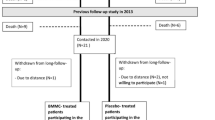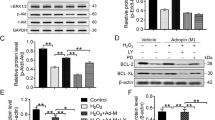Abstract
Experimental data indicate that stem cell mobilization with granulocyte colony-stimulating factor (G-CSF) might have potential as a novel therapeutic strategy for acute myocardial infarction. The prospective beneficial effects of G-CSF can be attributed mainly to a direct action on injured myocardium rather than on differentiation of mobilized bone marrow stem cells into cardiac myocytes. This article reviews the evidence for the potential cardioprotective effects of G-CSF and discusses future investigations regarding pharmacologic stem cell activation and mobilization with G-CSF in the setting of acute myocardial infarction.
Key Points
-
Experimental data indicate that stem cell mobilization with granulocyte colony-stimulating factor (G-CSF) has potential as a novel regenerative strategy after acute myocardial infarction
-
The prospective beneficial effects of G-CSF can be attributed mainly to a direct action on injured myocardium rather than on differentiation of mobilized bone marrow stem cells into cardiac myocytes
-
Antiapoptotic and angiogenic effects of G-CSF could conceivably have an impact on left ventricular remodeling after acute myocardial infarction
-
With regards to future treatment strategies for acute myocardial infarction, further experimental and clinical studies are needed to identify effective and safe ways to use G-CSF
This is a preview of subscription content, access via your institution
Access options
Subscribe to this journal
Receive 12 print issues and online access
$209.00 per year
only $17.42 per issue
Buy this article
- Purchase on Springer Link
- Instant access to full article PDF
Prices may be subject to local taxes which are calculated during checkout
Similar content being viewed by others
References
Jessup M and Brozena S (2003) Heart failure. N Engl J Med 348: 2007–2018
Nian M et al. (2004) Inflammatory cytokines and postmyocardial infarction remodeling. Circ Res 94: 1543–1553
Papayannopoulou T (2004) Current mechanistic scenarios in hematopoietic stem/progenitor cell mobilization. Blood 103: 1580–1585
Orlic D et al. (2001) Bone marrow cells regenerate infarcted myocardium. Nature 410: 701–705
Orlic D et al. (2001) Mobilized bone marrow cells repair the infarcted heart, improving function and survival. Proc Natl Acad Sci U S A 98: 10344–10349
Ohtsuka M et al. (2004) Cytokine therapy prevents left ventricular remodeling and dysfunction after myocardial infarction through neovascularization. FASEB J 18: 851–853
Minatoguchi S et al. (2004) Acceleration of the healing process and myocardial regeneration may be important as a mechanism of improvement of cardiac function and remodeling by postinfarction granulocyte colony-stimulating factor treatment. Circulation 109: 2572–2580
Kawada H et al. (2004) Nonhematopoietic mesenchymal stem cells can be mobilized and differentiate into cardiomyocytes after myocardial infarction. Blood 104: 3581–3587
Iwanaga K et al. (2004) Effects of G-CSF on cardiac remodeling after acute myocardial infarction in swine. Biochem Biophys Res Commun 325: 1353–1359
Harada M et al. (2005) G-CSF prevents cardiac remodeling after myocardial infarction by activating the Jak-Stat pathway in cardiomyocytes. Nat Med 11: 305–311
Sugano Y et al. (2005) Granulocyte colony-stimulating factor attenuates early ventricular expansion after experimental myocardial infarction. Cardiovasc Res 65: 446–456
Deindl E et al. (2006) G-CSF administration after myocardial infarction in mice attenuates late ischemic cardiomyopathy by enhanced arteriogenesis. FASEB J 20: 956–958
Ueda K et al. (2006) Granulocyte colony stimulating factor directly inhibits myocardial ischemia-reperfusion injury through Akt-endothelial NO synthase pathway. Arterioscler Thromb Vasc Biol 26: e108−e113
Norol F et al. (2006) Influence of mobilized stem cells on myocardial infarct repair in a nonhuman primate model. Blood 102: 4361–4368
Deten A et al. (2005) Hematopoietic stem cells do not repair the infarcted mouse heart. Cardiovasc Res 65: 52–63
Dawn B et al. (2006) Postinfarct cytokine therapy regenerates cardiac tissue and improves left ventricular function. Circ Res 98: 1098–1105
Hope SA and Meredith IT (2003) Cellular adhesion molecules and cardiovascular disease. Part I. Their expression and role in atherogenesis. Intern Med J 33: 380–386
Kronenwett R et al. (2000) The role of cytokines and adhesion molecules for mobilization of peripheral blood stem cells. Stem Cells 18: 320–330
Weber C (2003) Novel mechanistic concepts for the control of leukocyte transmigration: specialization of integrins, chemokines, and junctional molecules. J Mol Med 81: 4–19
Iwasaki H et al. (2006) Dose-dependent contribution of CD34-positive cell transplantation to concurrent vasculogenesis and cardiomyogenesis for functional regenerative recovery after myocardial infarction. Circulation 113: 1311–1325
Broxmeyer HE et al. (2005) Rapid mobilization of murine and human hematopoietic stem and progenitor cells with AMD3100, a CXCR4 antagonist. J Mol Med 201: 1307–1318
Orschell-Traycoff CM et al. (2000) Homing and engraftment potential of Sca-1(+)lin(–) cells fractionated on the basis of adhesion molecule expression and position in cell cycle. Blood 96: 1380–1387
Liles WC et al. (2003) Mobilization of hematopoietic progenitor cells in healthy volunteers by AMD3100, a CXCR4 antagonist. Blood 102: 2728–2730
Liles WC et al. (2004) Augmented mobilization and collection of CD34+ hematopoietic cells from normal human volunteers stimulated with G-CSF by single-dose administration of AMD3100, a CXCR4 antagonist. Transfusion 45: 295–300
Author information
Authors and Affiliations
Corresponding author
Ethics declarations
Competing interests
The authors declare no competing financial interests.
Rights and permissions
About this article
Cite this article
Ince, H., Nienaber, C. Future investigations in stem cell activation with granulocyte-colony-stimulating factor after myocardial infarction. Nat Rev Cardiol 4 (Suppl 1), S119–S122 (2007). https://doi.org/10.1038/ncpcardio0732
Received:
Accepted:
Issue Date:
DOI: https://doi.org/10.1038/ncpcardio0732
This article is cited by
-
Bone marrow-derived mesenchymal stem cells migrate to healthy and damaged salivary glands following stem cell infusion
International Journal of Oral Science (2014)
-
Altered myocardial glucose utilization and the reverse mismatch pattern on rubidium-82 perfusion/F-18-FDG PET during the sub-acute phase following reperfusion of acute anterior myocardial infarction
Journal of Nuclear Cardiology (2011)
-
Zellbasierte Strategien für die Speicheldrüsenregeneration
HNO (2008)



